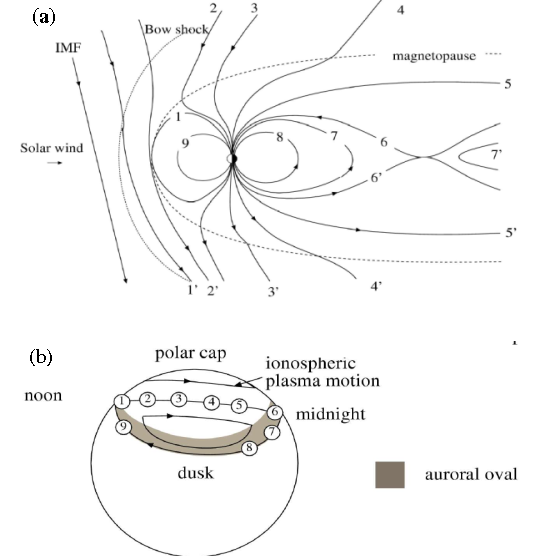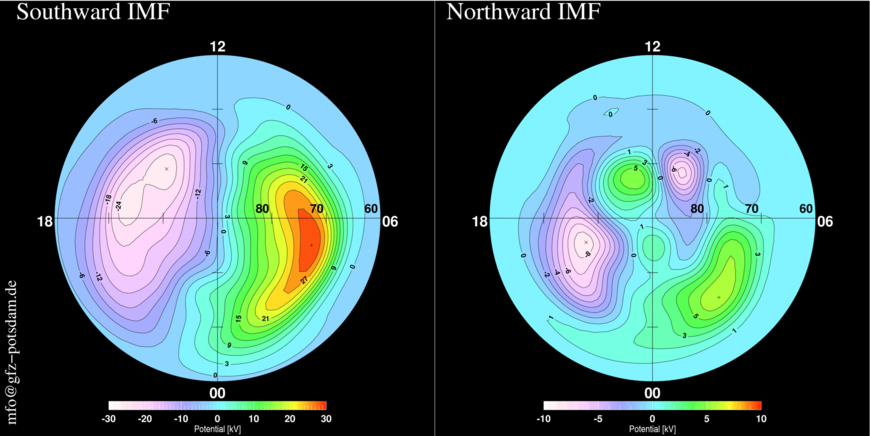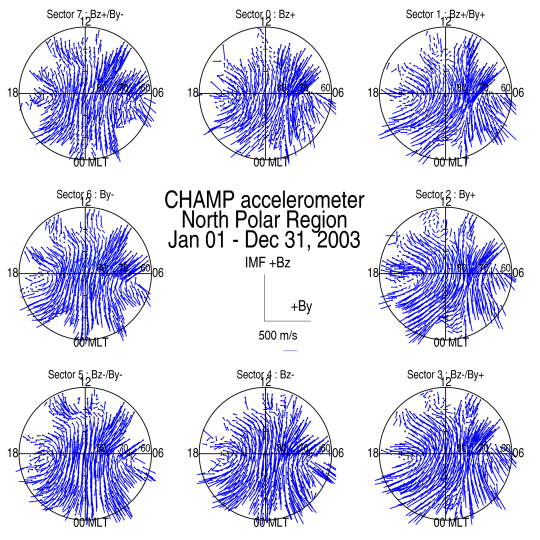The Sun constantly emits a stream of plasma, the solar wind, carrying a magnetic field of variable direction, the interplanetary magnetic field, or IMF for short. The interaction between the solar wind and its IMF in particular with Earth's magnetosphere causes a large-scale plasma movement within the magnetosphere that appears as a permanent and highly variable plasma circulation in the high-latitude polar ionosphere.

When the magnetized plasma of the solar wind encounters the Earth's magnetic field, it is forced to flow around it, leaving behind it a cavity, the magnetosphere, which is separated from the solar wind by a boundary, called the magnetopause. When the IMF has a southerly direction, it can connect with the Earth's northward-directed field at the front of the magnetosphere, via a universal plasma process, referred to as magnetic reconnection. This magnetic connection allows solar wind plasma to enter the magnetosphere. Once connected with the IMF, the terrestrial field lines, and the plasma that sits on them, are carried by the solar wind over the Earth's poles downstream, penetrating deeper and deeper into the Earth's magnetotail, where they eventually reconnect once more to form closed field lines. The field lines are subsequently transported sunward past the Earth, until they again meet the IMF at the magnetopause, allowing the whole process to start all over (Fig. 1a).
This large-scale plasma and magnetic field circulation extends all the way down to the ionosphere, the ionized portion of Earth's upper atmosphere. The result is a two-cell pattern, with anti-sunward flow over the polar caps, returning at lower latitudes to the dayside via the dawn and dusk flanks (Fig. 1b).
Since plasma flow in the presence of a magnetic field produces an electric field transverse to the flow, the convection is equivalent to an electric potential across the polar caps, which can be more than 100 kV during periods of strongly southward IMF. Measurements by the Electron Drift Instrument (EDI) on board the Cluster spacecraft at large distances within the Earth's magnetosphere have been used to construct detailed maps of the plasma convection in Earth's ionosphere. Any comparison with ionospheric convection measurements thus requires mapping the EDI measurements to ionospheric altitudes. This method and the IMF-dependence of the resulting high-latitude plasma convection is described in the paper of Haaland et al., 2007. In a second paper, based on the same data set and methodology, we investigated the dependence of the high-latitude convection pattern on various solar wind parameters and presented spatial patterns of the convection's variances (Förster et al., 2007). The convection and its variability in particular play a major role in Joule heating of the ionosphere and thermosphere (see below).

The derived patterns are exactly what is expected from magnetic reconnection between the interplanetary magnetic field and Earth's magnetic field, with the addition of some feedback from the ionosphere. Fig. 2a shows the electric field potentials of the statistically averaged convection pattern obtained over the Northern Hemisphere for strictly southward IMF. Under such conditions the convection results in a clear two-cell pattern. The equipotential lines can be considered as streamlines of the ionospheric plasma, so that the pattern represents a strong antisolar flow over the central polar cap completed with return flows at lower, auroral and subauroral latitudes. For northward IMF (Fig. 2b), the convection pattern is strikingly different. The reconnection site moves from the frontside to the region tailward of the cusps, where interplanetary field lines now reconnect with oppositely directed polar cap field lines that were already open. As a result, four convection cells appear: one pair at high latitudes, poleward of the cusp position, that indicates a sunward convection over parts of the polar cap, while the other pair at lower latitudes, slighly shifted to the nightside, shows a weakend antisunward convection. The smaller potential values and the very different convection pattern tells us, that there are different processes that are responsible for the coupling between the solar wind and the magnetosphere.
The plasma convection acts as an important driver of the upper thermosphere (> ~100 km altitude) at high latitudes. Subject to the local plasma density, the response of the high-latitude thermosphere is not immediate, but is rather measured in tens of minutes to hours. The inertia of the thermospheric neutral winds, on the other hand, can help to maintain the ionospheric convection independently of the magnetospheric driver processes. This is known for long time as the 'fly-wheel' effect. Neutral thermospheric wind pattern at high latitudes obtained from cross-track acceleration measurements of the CHAMP satellite above both North and South polar regions have been statistically analyzed in their dependence on the IMF direction (clock angle) of the solar wind (Förster et al., 2008, Annales Geophysicae).
(Text is partly adopted from the MPE Yearbook 2006, section 2.4.)


